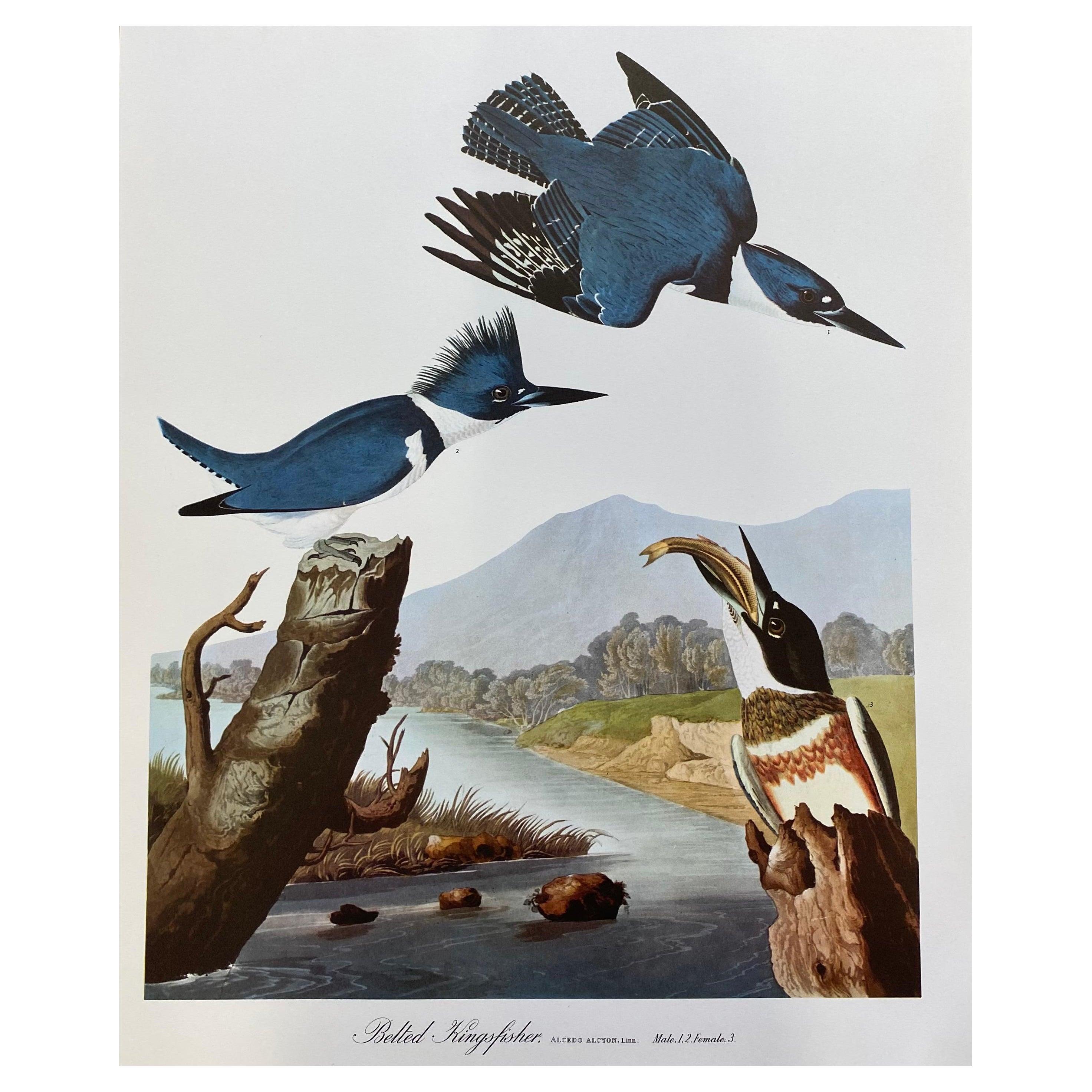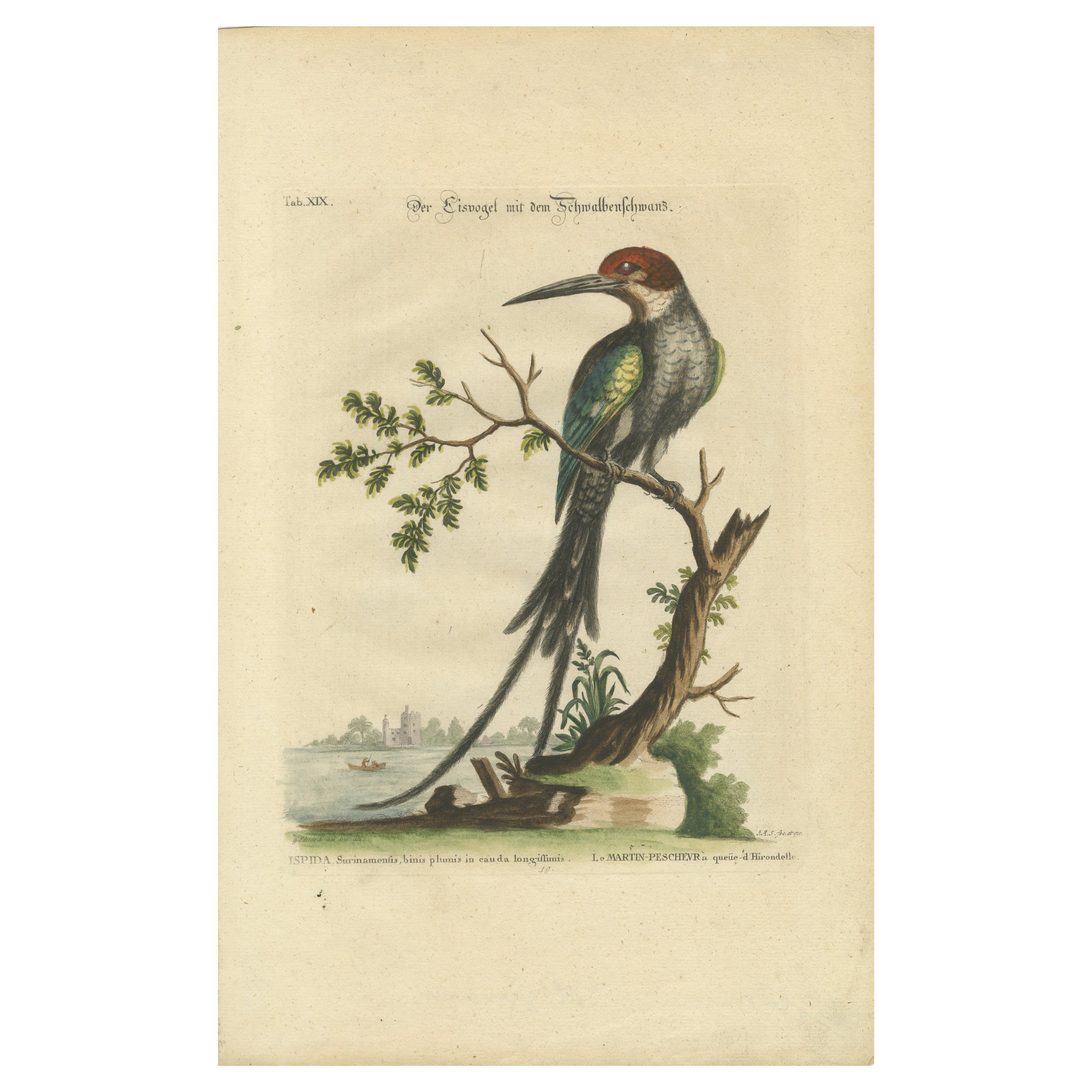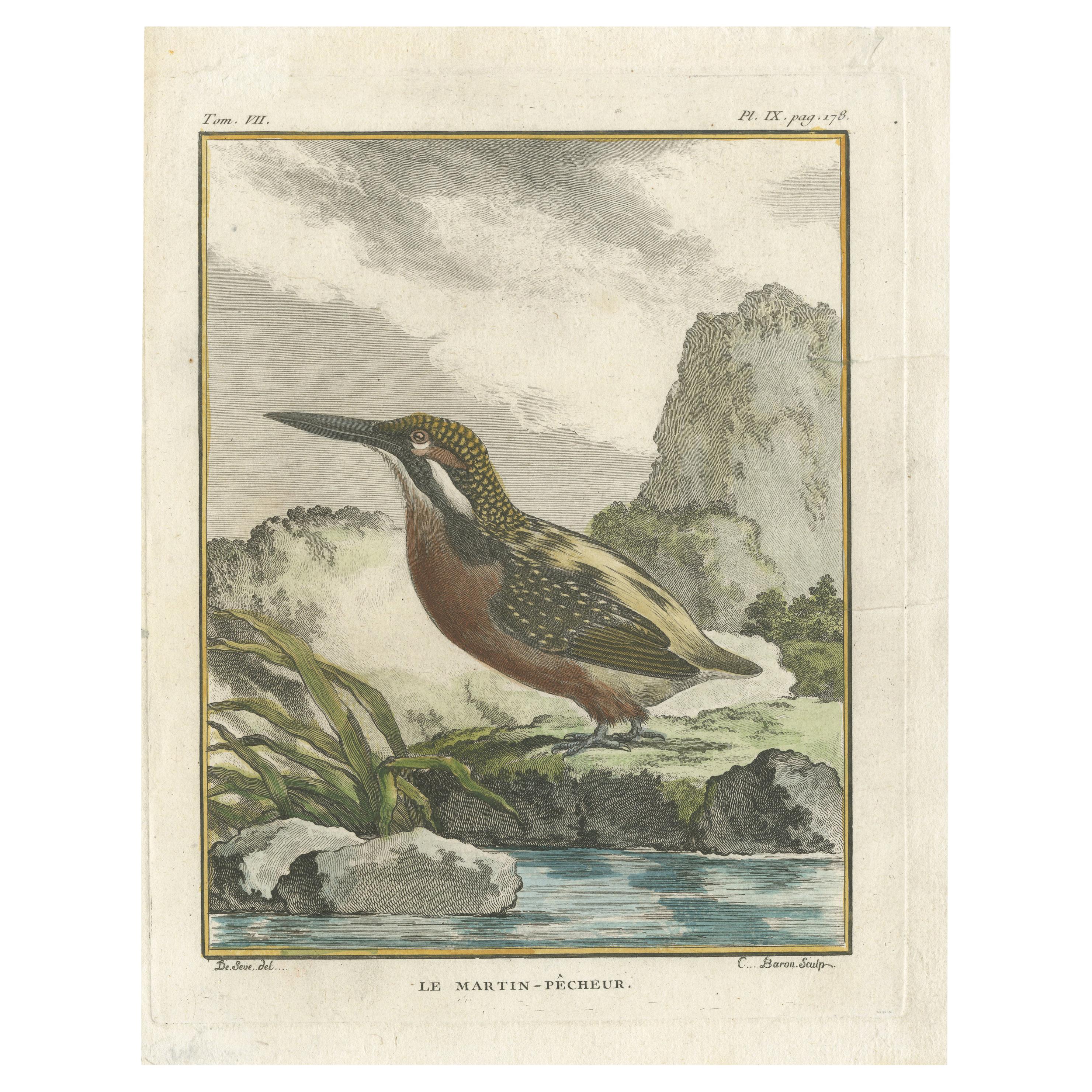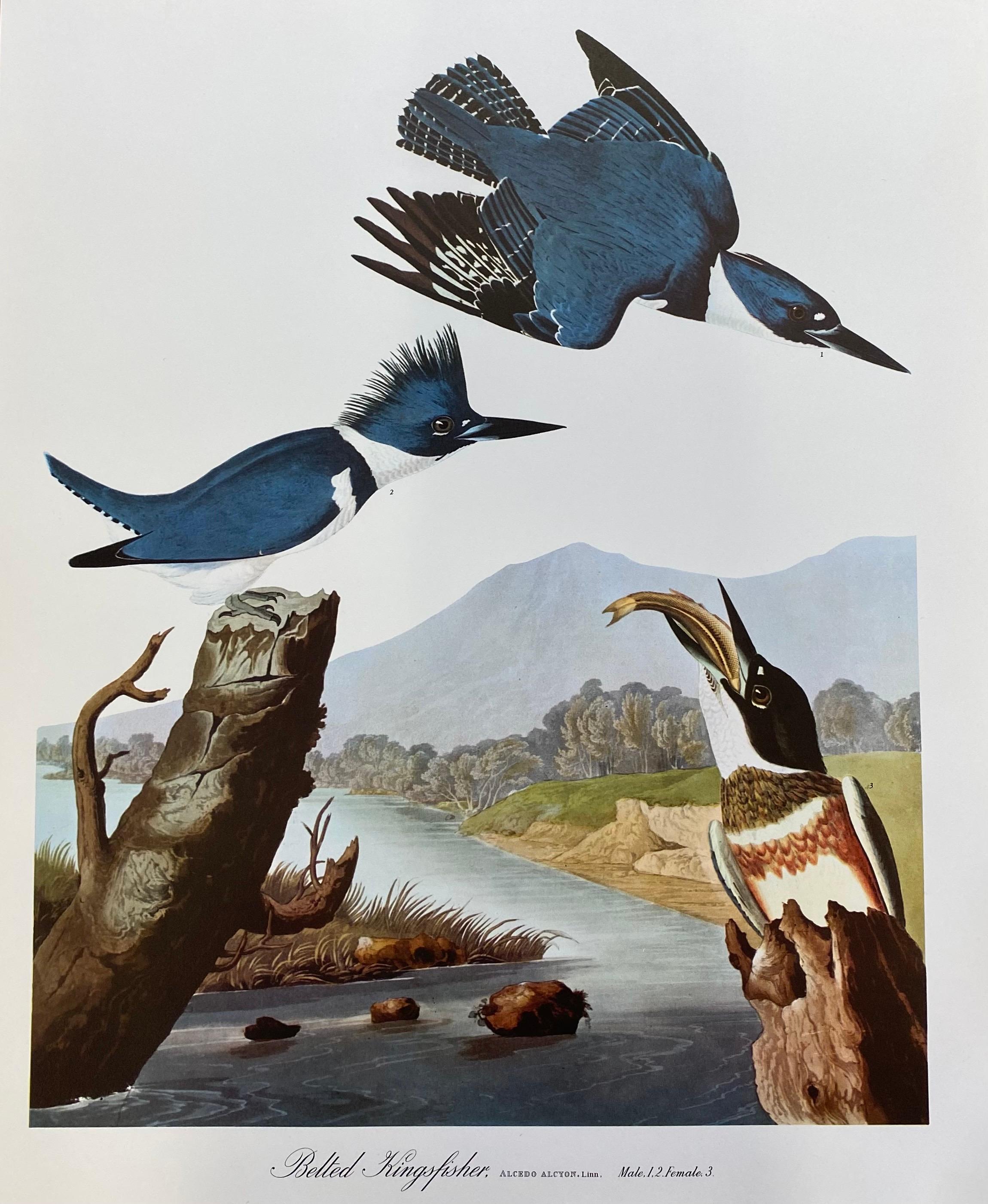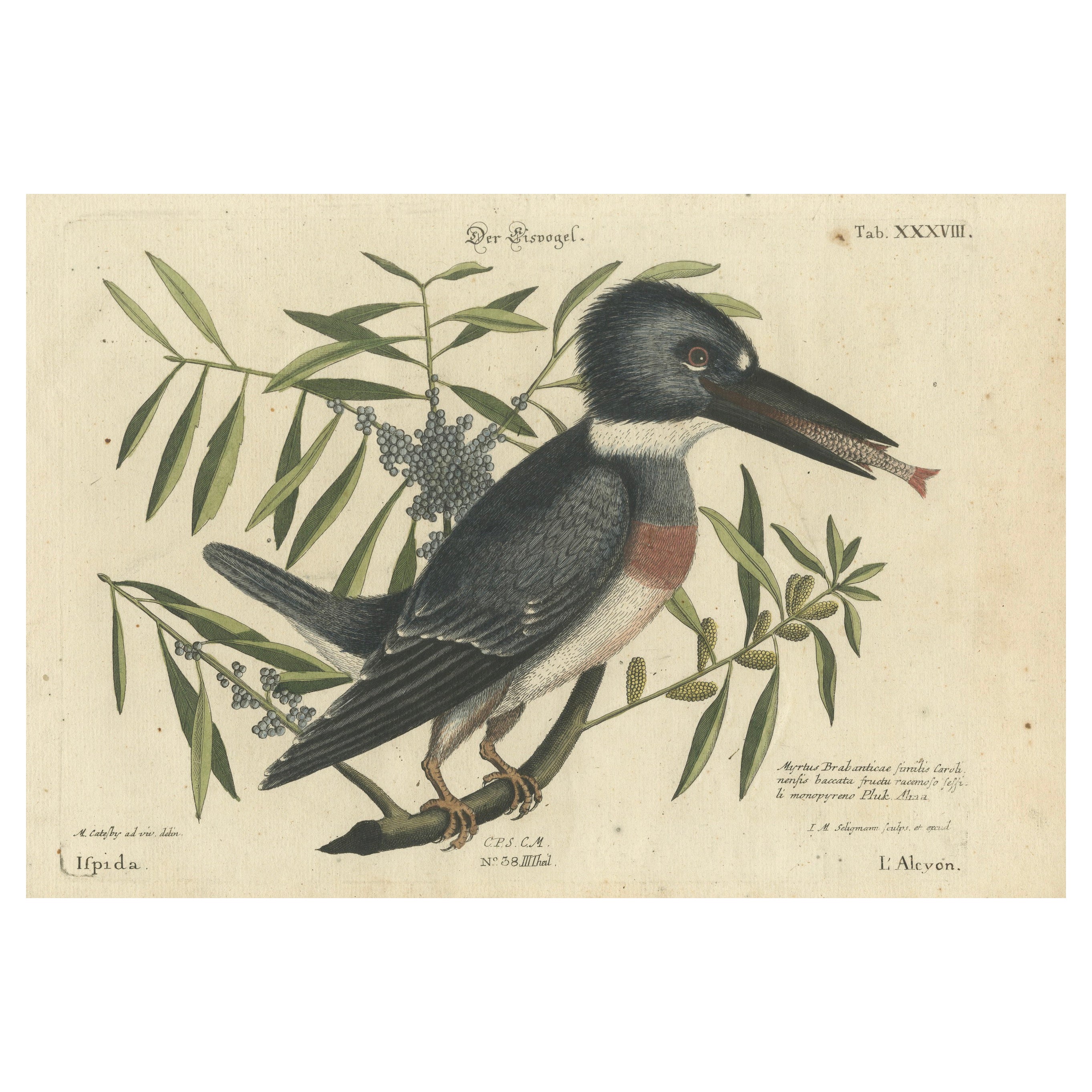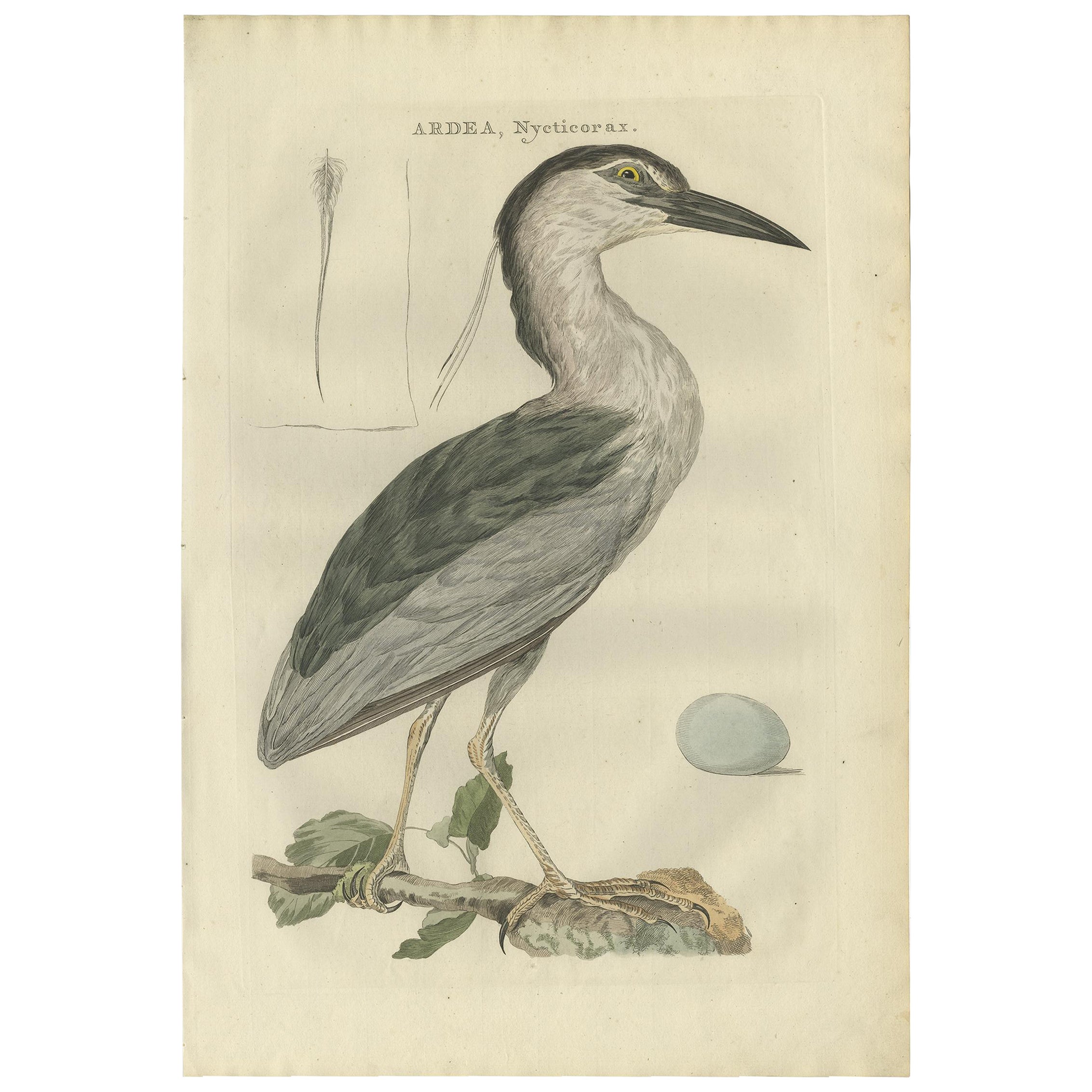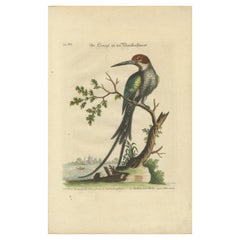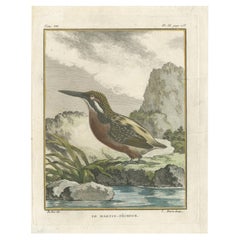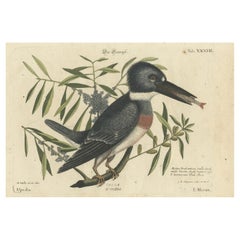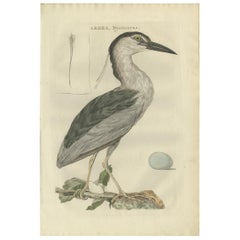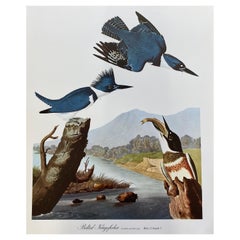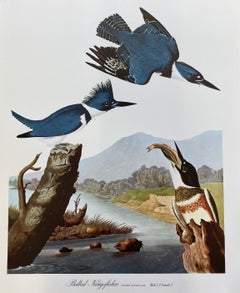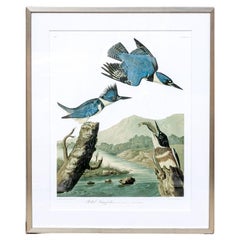Items Similar to Majestic Hunter: The American Belted Kingfisher in Its Natural Habitat, 1749
Want more images or videos?
Request additional images or videos from the seller
1 of 6
Majestic Hunter: The American Belted Kingfisher in Its Natural Habitat, 1749
$326.25
$407.8220% Off
£246.06
£307.5720% Off
€280
€35020% Off
CA$451.07
CA$563.8420% Off
A$505.28
A$631.6020% Off
CHF 265.39
CHF 331.7420% Off
MX$6,144.03
MX$7,680.0420% Off
NOK 3,360.71
NOK 4,200.8920% Off
SEK 3,190.22
SEK 3,987.7820% Off
DKK 2,131.54
DKK 2,664.4320% Off
About the Item
Original hand-colored antique bird print showing an American Kingfisher from the book "A Natural History of Uncommon Birds" (1743-1751) by George Edwards.
This hand-colored engraving showcases the bird perched on a branch, holding a fish in its beak.
The kingfisher is characterized by its distinctive plumage, with a slate-blue back and wings, a speckled tail, and a prominent crest on its head. Its body is white underneath with some pinkish hues near the breast. The bird's sharp beak is shown spearing a fish, emphasizing its hunting prowess. The surrounding environment includes a simple background with water and vegetation, highlighting the bird's natural habitat. This illustration is part of an increasingly rare and treasured collection of natural history artwork from the 18th century.
George Edwards (1694–1773) was an English naturalist and ornithologist who is often referred to as the "father of British ornithology." His most famous work, "A Natural History of Uncommon Birds" (1743-1751), and its continuation "Gleanings of Natural History" (1758-1764), contain detailed illustrations and descriptions of many bird species, many of which were little known or newly discovered at the time. Edwards' work is highly regarded for its accuracy, artistry, and contribution to the field of ornithology.
About George Edwards:
1. **Early Life and Career**:
- Born in Stratford, Essex, Edwards was apprenticed to a tradesman in London. However, he developed an interest in natural history and began studying birds, insects, and other animals.
- He spent some time traveling in Europe, studying various collections of natural history specimens.
2. **Publications**:
- **"A Natural History of Uncommon Birds" (1743-1751)**: This work is a collection of 210 hand-colored engravings of birds. It is known for its meticulous attention to detail and accuracy in depicting bird species.
- **"Gleanings of Natural History" (1758-1764)**: This series continued the work started in "A Natural History of Uncommon Birds" and included additional birds as well as other animals.
- His publications also included detailed observations and descriptions, making them valuable not only for their artistic merit but also for their scientific content.
3. **Artistic and Scientific Contributions**:
- Edwards was known for his ability to combine artistic skill with scientific precision. His illustrations often depicted birds in lifelike poses and settings, showing their natural behaviors.
- He collaborated with and was influenced by other naturalists and illustrators of his time, such as Carl Linnaeus and Mark Catesby.
- Edwards' works were used by Linnaeus in the development of his system of taxonomy.
4. **Legacy**:
- George Edwards' contributions to ornithology and natural history have had a lasting impact. His detailed and accurate illustrations helped to advance the study of birds and influenced subsequent generations of naturalists and artists.
- His books remain highly prized by collectors and are considered important historical documents in the field of natural history.
### "A Natural History of Uncommon Birds" and Its Importance:
- **Illustrations**: Each illustration in Edwards' work was carefully hand-colored, and the engravings were often accompanied by descriptive text that included observations about the birds' habitats, behaviors, and physical characteristics.
- **Scientific Accuracy**: Edwards took great care to ensure the accuracy of his depictions, often working from specimens he had observed firsthand.
- **Influence**: The work was well-received in its time and remains a significant reference for ornithologists and historians. It contributed to a greater understanding and appreciation of bird species from around the world.
Overall, George Edwards' work represents a critical intersection of art and science during the Enlightenment period, capturing the beauty and diversity of the natural world while contributing to the scientific knowledge of his time.
-------------
The bird depicted is a Belted Kingfisher (Megaceryle alcyon), a species commonly found in North America. Here are details about its habitat, as well as some remarkable facts about the bird:
### Habitat:
1. **Geographic Range**:
- Belted Kingfishers are widespread across North America. They are found from Alaska and Canada down through the United States, and into Mexico and Central America during the winter.
2. **Preferred Environment**:
- These birds are typically found near bodies of water, such as rivers, lakes, streams, ponds, and coastal areas. They prefer clear waters where they can easily spot and catch fish.
### Remarkable Facts:
1. **Hunting and Diet**:
- **Diet**: The Belted Kingfisher primarily feeds on fish. It dives into the water to catch its prey, using its sharp beak. Besides fish, it may also eat amphibians, crustaceans, insects, small mammals, and reptiles.
- **Hunting Technique**: Kingfishers are known for their remarkable hunting skills. They hover above the water before diving headfirst to capture fish. They can also spot prey from a perch above the water.
2. **Nesting**:
- **Burrow Nesting**: Unlike many other birds, Belted Kingfishers nest in burrows that they dig into sandbanks or earthen embankments near water. These burrows can be up to 8 feet long and provide a safe and secure place for their eggs.
- **Breeding**: Both male and female kingfishers take part in excavating the burrow. The female lays 5 to 8 eggs, and both parents help incubate them and feed the chicks.
3. **Appearance and Sexual Dimorphism**:
- **Plumage**: Belted Kingfishers have a distinctive blue-gray plumage with a white collar and belly. They also have a shaggy crest on their head.
- **Sexual Dimorphism**: Females are unique in that they have an additional rusty band across their chest, which males lack. This makes the females more colorful than the males, which is unusual among birds.
4. **Behavior**:
- **Vocalization**: They are known for their loud, rattling call, which they use frequently, especially when disturbed or during flight.
- **Territorial**: Belted Kingfishers are highly territorial and can often be seen chasing away intruders from their hunting and nesting areas.
5. **Migration**:
- **Partial Migrants**: While some populations of Belted Kingfishers are migratory, moving south during the winter, others are resident year-round, particularly in warmer regions where water bodies remain unfrozen.
6. **Conservation Status**:
- **Adaptability**: The Belted Kingfisher is listed as a species of least concern due to its wide range and stable population. It has adapted well to a variety of aquatic environments and is a common sight in its preferred habitats.
These facts highlight the Belted Kingfisher's adaptability, unique nesting habits, and specialized hunting skills, making it a fascinating subject for both ornithologists and bird watchers alike.
- Dimensions:Height: 11.15 in (28.3 cm)Width: 8.94 in (22.7 cm)Depth: 0.01 in (0.1 mm)
- Materials and Techniques:
- Period:1740-1749
- Date of Manufacture:1749
- Condition:Condition: Good. General age-related toning and/or occasional minor defects from handling. Has been framed before, hence a darker tone on the outer borders, not affecting the image. Please study scan carefully.
- Seller Location:Langweer, NL
- Reference Number:Seller: BG-13535-221stDibs: LU3054340098972
About the Seller
5.0
Recognized Seller
These prestigious sellers are industry leaders and represent the highest echelon for item quality and design.
Platinum Seller
Premium sellers with a 4.7+ rating and 24-hour response times
Established in 2009
1stDibs seller since 2017
2,517 sales on 1stDibs
Typical response time: <1 hour
- ShippingRetrieving quote...Shipping from: Langweer, Netherlands
- Return Policy
Authenticity Guarantee
In the unlikely event there’s an issue with an item’s authenticity, contact us within 1 year for a full refund. DetailsMoney-Back Guarantee
If your item is not as described, is damaged in transit, or does not arrive, contact us within 7 days for a full refund. Details24-Hour Cancellation
You have a 24-hour grace period in which to reconsider your purchase, with no questions asked.Vetted Professional Sellers
Our world-class sellers must adhere to strict standards for service and quality, maintaining the integrity of our listings.Price-Match Guarantee
If you find that a seller listed the same item for a lower price elsewhere, we’ll match it.Trusted Global Delivery
Our best-in-class carrier network provides specialized shipping options worldwide, including custom delivery.More From This Seller
View AllThe Surinamese Kingfisher Bird with the Swallow Tail Engraved in 1749
Located in Langweer, NL
This engraving is from the Johann Michael Seligmann's collection, based on the works of George Edwards that was published in 1743.
The text in the image is in both German and Latin...
Category
Antique 1740s Prints
Materials
Paper
$643 Sale Price
20% Off
Free Shipping
Antique Bird Print of a Kingfisher by Buffon '1780'
Located in Langweer, NL
Antique bird print titled 'Le Martin-Pêcheur'. Original antique print of a kingfisher. This print originates from 'Histoire naturelle des oiseaux' by George-...
Category
Antique Late 18th Century Prints
Materials
Paper
$186 Sale Price
20% Off
Hand-Colored Engraving of the Kingfisher by Johann Michael Seligmann, ca.1770
Located in Langweer, NL
Title: Der Eisvogel - Hand-Colored Engraving of the Kingfisher by Johann Michael Seligmann, 18th Century
This charming hand-colored engraving, titled 'Der Eisvogel', depicts the Ki...
Category
Antique 1770s Prints
Materials
Paper
$615 Sale Price
20% Off
Antique Bird Print of the Black-Crowned Night Heron by Sepp & Nozeman, 1789
Located in Langweer, NL
Antique print titled 'Ardea, Nycticorax'. This print depicts the black-crowned night heron with egg (Dutch: kwak). The black-crowned night heron (Nycticorax nycticorax), or black-cap...
Category
Antique 18th Century Prints
Materials
Paper
Antique Bird Print Depicting Three Species of Kingfisher, circa 1850
Located in Langweer, NL
Antique bird print titled 'Le Martin Pêcheur - Le Martin Pêcheur (gros-bec) - Le Martin Pêcheur (tête-grise) '. Lithograph depicting three species of kingfis...
Category
Antique Mid-19th Century Prints
Materials
Paper
$139 Sale Price
20% Off
Tropical & European Birds Print: Toucan, Trogon, Kingfisher – Antique 1867
Located in Langweer, NL
Tropical & European Birds Print: Toucan, Trogon, Kingfisher – Antique 1867
This beautiful antique print depicts a variety of tropical and European birds, including toucans, trogons,...
Category
Antique 1860s German Prints
Materials
Paper
You May Also Like
Large Classical Bird Color Print after John James Audubon, Belted Kingfisher
Located in Cirencester, Gloucestershire
Classical Bird print,
after John James Audubon,
printed by Harry N. Abrams, Publishers, New York
unframed, 17 x 14 inches color print on paper
condition: very good
provenance: from...
Category
20th Century Victorian Animal Prints
Materials
Acrylic
Large Classical Bird Color Print after John James Audubon - Belted Kingfisher
By After John James Audubon
Located in Cirencester, Gloucestershire
Classical Bird print,
after John James Audubon,
printed by Harry N. Abrams, Publishers, New York
unframed, 17 x 14 inches color print on pap...
Category
20th Century Victorian Animal Prints
Materials
Color
After J.J. Audubon, Color Photo Lithograph Reprint Belted Kingsfisher
By John James Audubon
Located in Bridgeport, CT
The original engraved and printed by Havell. This lithograph reprint is most likely from one of several large format limited editions on fine white paper.
Handsomely presented matte...
Category
20th Century Country Prints
Materials
Acrylic, Wood, Paper
Francois Nicholas Martinet Bird Engraving, circa 1770
By François Nicolas Martinet
Located in Downingtown, PA
Francois Nicholas Martinet bird engraving,
circa 1770.
The framed Francois Martinet engraving is from Buffon's Historie Naturelle des Oiseaux displa...
Category
Antique 1770s French Georgian Prints
Materials
Paper
Florida Cormorant Amsterdam Audubon Edition
Located in Colorado Springs, CO
This is a stunning color lithograph of the “Florida Cormorant”, Plate 252 from the 1971-1972 “Amsterdam Audubon” edition of James John Audubon’s epic...
Category
Vintage 1970s Dutch Prints
Materials
Paper
Black Crowned Night Heron, French antique natural history water bird art print
Located in Melbourne, Victoria
Heron Bihoreau - Black Crowned Night Heron
French chromolithograph, published in 1931. Printed title lower right of sheet. Plate number top right. From a French series of illustrati...
Category
1930s Art Deco Animal Prints
Materials
Lithograph
More Ways To Browse
Used Dive Watch
George Edwards Engravings
George Edwards Bird Prints
Crest Watch
Weller Kingfisher
Pair Large Ginger Jar
Pair Onyx Columns
Pink Ginger Jar
Porcelain Chickens
Porcelain Perfume Bottles
Porcelain Tazza
Puppets And Marionettes
Rabbit Pottery
Red Buddha Statue
Repousse Brass Box
Retro French Kitchen Posters
Robert John Cabinet
Rococo Dolphin
